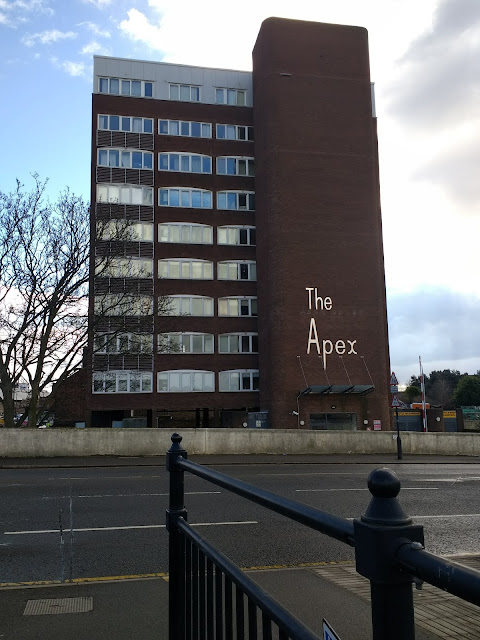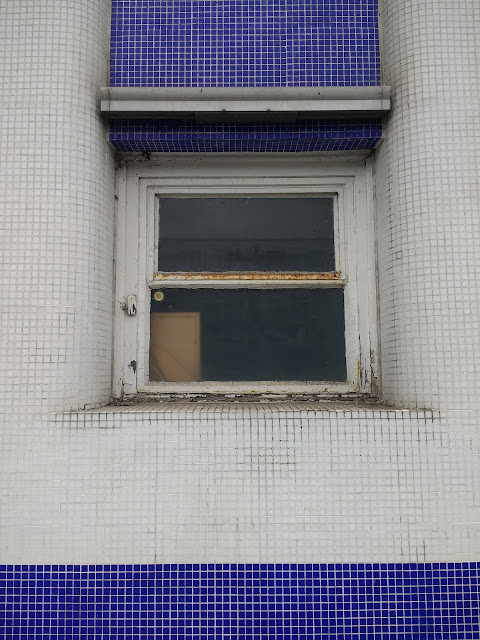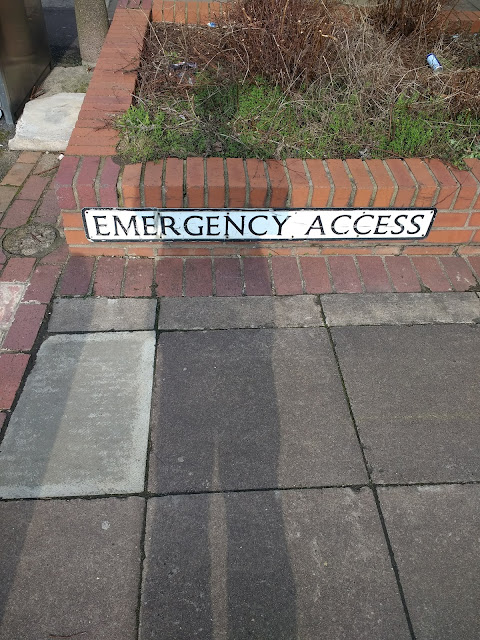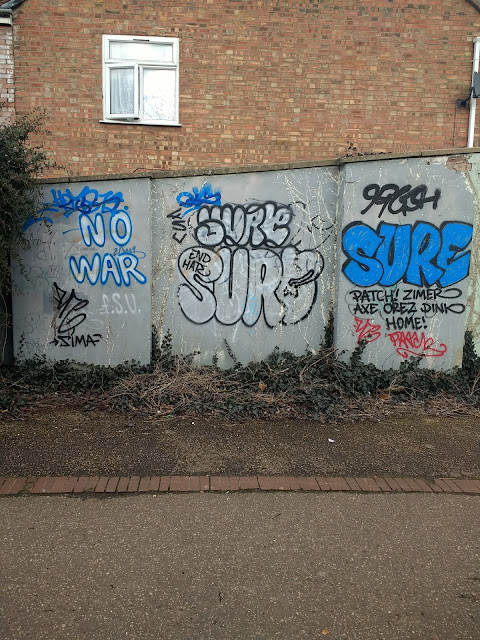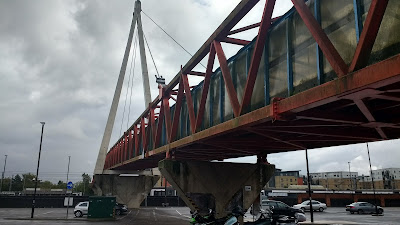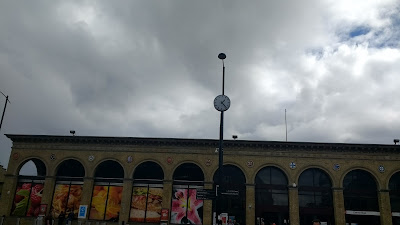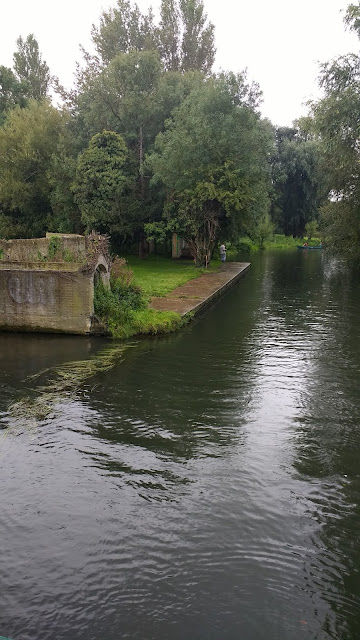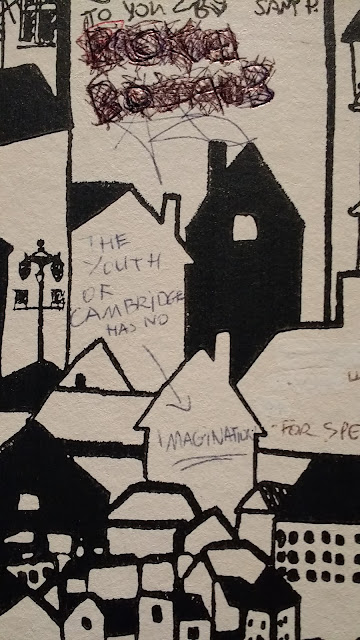27th Feb 2018
I decided to walk to 'The Apex'. A brown tower block, a clearly visible landmark from the train window every morning. It looked like a regular block of flats but for the brown chimney-like edifice on the front bearing it's name. In large plastic letters in a typeface from an earlier age. From the train I'd imagined it as the headquarters of some sort of bizarre state organisation. The Avengers, The Men from UNCLE, that sort of thing.
The Apex was at the limits of the distance I could travel in a lunchtime (without resorting to running or walking too fast). On route I passed a disused/up for sale police station in a brown block building (60s?). The words 'Police' and 'Peterbrough' visible above the door in spectral form. A sign of austere times perhaps, a retreat from the beat.
By contrast, just the other side of the river, the 'Fletton Quays ' development. Featuring 'high spec' flats as well as shops and a new Council Office. The computer generated mock up on the advert almost identical to those in almost identical developments elsewhere. Showing virtual reality well dressed professional types drinking coffee outside a poorly disguised Costa. And a man dressed in a gold suit and top hat, a human statue, looking like an alien ringmaster presiding over a circus of sterility. At least the word 'luxury' wasn't evident in the marketing, which is something I suppose.
I reached the Apex, not far away the other side of the main road. It seemed opposite to the new development, not just in proximity. I learned later that the building was formerly an office occupied by Emap, the publish/publication subscription service company. I remembered the name from working in a Government Department which purchased some obscure (and undoubtedly dull) publications from them. In around 2003, according to Skyscraper News, the building was sold for residential development. So no Avengers or Men from UNCLE. Unless in a 'private' capacity. Could a 'John Steed' be dwelling within? Or at least a radio ham, broadcasting and intercepting numbers stations from the top floor? I doubt I will ever know.
I made it back to work with 1 minute to spare.
Drifting, meandering and aimless wandering..the perambulations and musings of Mr H in London, Cambridge and elsewhere.
Tuesday 27 February 2018
Monday 26 February 2018
Anonymous?
Mon 26th Feb, 2018
Needed to buy lunch having left mine at home during my somnambulant departure this morning. A combination of biting cold and hunger made me dither in deciding what to have. Feeling harassed, I ended up walking (at some pace) down various streets adjacent to the main shopping area, hoping for random inspiration. Conscious of limited time and the need to procure an emergency umbrella to keep at the office. The threat of snow had reminded me of this necessity.
A lamp post on one of these side streets has a yellow sticker depicting the Guy Fawkes mask. The one associated with V for Vendetta and later adopted by the people collectively known as 'Anonymous'.
This made me think about my own anonymity while walking around. Am I anonymous? I hoped so. I assume that nobody takes any notice of me on my lunchtime perambulations. I imagine I just look like an office worker in an overcoat. On quiet side streets, when there are people, I walk with purpose to give the impression I know where i'm going. But maybe I've already been clocked as some sort of stranger. A Nosey Parker. Someone from the council. A spy. Or just a nutter.
I walked through the Queensgate Shopping Centre, having thought about going to John Lewis for a Fulton umbrella. The shopping mall was stifling, as I should have known it would be. Having briefly joined the blank shuffling shoppers, becoming one of them momentarily, I abandoned my search for John Lewis and walked in any direction to escape the overheated piped music hell. Not thinking clearly, having to give up the mini-quest for the Fulton.
Back outside, a hastily procured lunch at a chain noodle joint before securing a cheaper but far inferior Dunlop umbrella from Sports Direct. Then heading back to work slightly late and under-refreshed. But hopefully still at least anonymous.
Needed to buy lunch having left mine at home during my somnambulant departure this morning. A combination of biting cold and hunger made me dither in deciding what to have. Feeling harassed, I ended up walking (at some pace) down various streets adjacent to the main shopping area, hoping for random inspiration. Conscious of limited time and the need to procure an emergency umbrella to keep at the office. The threat of snow had reminded me of this necessity.
A lamp post on one of these side streets has a yellow sticker depicting the Guy Fawkes mask. The one associated with V for Vendetta and later adopted by the people collectively known as 'Anonymous'.
This made me think about my own anonymity while walking around. Am I anonymous? I hoped so. I assume that nobody takes any notice of me on my lunchtime perambulations. I imagine I just look like an office worker in an overcoat. On quiet side streets, when there are people, I walk with purpose to give the impression I know where i'm going. But maybe I've already been clocked as some sort of stranger. A Nosey Parker. Someone from the council. A spy. Or just a nutter.
I walked through the Queensgate Shopping Centre, having thought about going to John Lewis for a Fulton umbrella. The shopping mall was stifling, as I should have known it would be. Having briefly joined the blank shuffling shoppers, becoming one of them momentarily, I abandoned my search for John Lewis and walked in any direction to escape the overheated piped music hell. Not thinking clearly, having to give up the mini-quest for the Fulton.
Back outside, a hastily procured lunch at a chain noodle joint before securing a cheaper but far inferior Dunlop umbrella from Sports Direct. Then heading back to work slightly late and under-refreshed. But hopefully still at least anonymous.
Saturday 24 February 2018
On Broadway......
Friday, last day of my first full week. Short walk to the City Market. Curry and rice for lunch from the food hall (only £3). I'd planned to explore the market a bit more but was put off by Phil Collins' 'In the air tonight' being piped out of somewhere. Forced away by this unwelcome aural intrusion, I found myself on Broad Street.
I was drawn to the Broadway Theatre. From the outside, more like a seaside theatre or bingo hall than something found on New York Broadway or in London's West End. Sort of slightly dilapidated art deco. The white and blue tiny mosaic tiles have a seaside quality. They hark back to an age when public lavatories were not clad with plastic, were more prevalent and were free (but probably more dangerous).
The window above in particular brought back memories of holidays in places like Great Yarmouth in the 70s and 80s. The weird seaside architecture of swimming pools, changing rooms, amusement arcades and (again) public loos.
I noticed amongst the events scheduled for the impressively diverse forthcoming programme: 'Doomwatch'. Disspointingly not an adaptation of the 70s BBC science fiction series. The advert resembled a still from the sort of poor quality conspiracy theory TV often found at the fag end of a flick through the freeview channels. The headline 'challenging conventional wisdom, seeking answers' suitably vague.
I went back to work. Friday. Short lunch, early escape.
Thursday 22 February 2018
Look carefully for Emergency Access (Road?)
Just before an abandoned pub, Temple City, a left turn. Scanning for the name of the street, out of the corner of my eye I notice the the sign at almost ground level. It comes into focus..'Emergency Access'. An odd name for a street. Or an odd position and design for something signposting emergency access, well disguised from approaching ambulances, police cars or fire engines.
Whether it allows access to an emergency or escape from one, or has some other meaning, it probably remains unnoticed by most, even those on foot. Time was against me, prohibiting an instinctive left turn. I carried on past the pub, one of many closed or abandoned in recent years in the UK. Another type of emergency.
Wednesday 21 February 2018
Mr Sharpe for Crowland, A.C. Ashpool for Stanground
Day 3, 21st Feb 2018
Star Road. A seemingly disused building, a church or community hall of some sort. Two in a series of carved blocks incorporated into the brickwork. Together they bear the riddle 'Mr Sharp for Crowland, A. C. Ashpool for Stanground'.
Crowland and Stanground are places, the former somewhere between Peterborough and Spalding, the latter a residential area in the City. But what of Sharpe and Cashpool and what were they for?
Star Road. A seemingly disused building, a church or community hall of some sort. Two in a series of carved blocks incorporated into the brickwork. Together they bear the riddle 'Mr Sharp for Crowland, A. C. Ashpool for Stanground'.
Crowland and Stanground are places, the former somewhere between Peterborough and Spalding, the latter a residential area in the City. But what of Sharpe and Cashpool and what were they for?
Tuesday 20 February 2018
Graffiti and the Ghost Face in the window
Day 2: 20th Feb.
A wander through a residential area near the Salem Chapel. Rows of terraces, slightly dilapidated.
Under a road bridge, then enticed to a footpath/cycleway heading vaguely in the direction back to work.
Graffiti: No war, end hate, Sure. A rhyming couplet of sorts. Who Patch, Zimmer, Axe, Orez and Dink are I will never know.
Distracted by this, I didn't notice the ghost-skull face in the window at the time. Staring out in my direction like a demonic watcher.
A wander through a residential area near the Salem Chapel. Rows of terraces, slightly dilapidated.
Under a road bridge, then enticed to a footpath/cycleway heading vaguely in the direction back to work.
Graffiti: No war, end hate, Sure. A rhyming couplet of sorts. Who Patch, Zimmer, Axe, Orez and Dink are I will never know.
Distracted by this, I didn't notice the ghost-skull face in the window at the time. Staring out in my direction like a demonic watcher.
Salem Chapel, AD 1978
Having been forced to move offices to Peterborough I am now a commuter. I've become a bit more time poor (and no more money rich). This means less time for longer walks (and blog writing) in the rambling semi-disorganised way I normally like to do things. While I'm skeptical when people (usually senior managers and politicians) tell us how we should positively embrace change and think it's always ever so marvellous, there are strategies that can be employed to cope with the unwelcome and unavoidable sort. One of mine will be using my truncated lunchtime to go for short walks in random directions to see what there is. This will also be a way of briefly escaping the office where the windows can't be opened for fear that fresh air and 'drafts' will interfere with the 'thermal comfort' system, as well as getting a bit of exercise.
Peterborough is somewhere I've been a few times but I've never had the chance to explore it that much so it's largely an unknown quantity and in that respect an intriguing prospect. It has connections with John Clare, and his walk from an asylum in Epping to Northborough, not far from Peterborough or his birthplace of Helpston. Iain Sinclair's book Edge of The Orison retraces these steps. So does the more recent Andrew Cotting film 'By Ourselves', including a brief scene in Peterborough on a bridge crossing the Ouse. There is the John Clare Theatre in the town centre. Other than that, I haven't come across any other psychogeographical references to the city.
Within the restricted range of a half hour (ish) lunchtime walk maybe I can do my bit to put Peterborough on the psychogeographical map. My intention is to take one photo of something I find. Then write something short about or inspired by it's subject, during the the confines of my commute. Sticking to this rule and having to be somewhat organised about it, will I suppose, mirror the stricter more time bound routine I will have to adopt as a commuter, but at the same time the walks will provide an escape and be an antidote to it.
Day 1, 19 Feb 2018. The Salem Chapel, Dickens Road.
Salem..said to be short for Jerusalem. A name most associated with the puritan City of Salem, Massachusetts and it's witch trials. Although there are countless other Salems in the world (and Salem Chapels). In pop culture , Steven Kings Salem's Lot (1975) and it's TV adaption starring David Soul from Starkey and Hutch (1979). One each side side of the establishment of this chapel. Salem the cat in Sabrina the Teenage Witch several years later. In the city of Salem the witchy element is used as a tourist draw these days. Maybe the same could be said of the original witch trials, at a more local level.
The building is unassuming and unspectacular, like most newer church buildings of an evangelical bent. More like a community centre. Made of brown brick. There was no sign of life and it was fenced off and apparently closed or under renovation. But maybe the Baptists are dormant, prepared for the next outbreak of witchcraft in Peterborough. Or they are waiting and plotting a new age of puritanism, a philosophy where life is more of a chore than a pleasure. I read that the Baptists have origins in the puritan movement. Also in Calvinism..a philosophy promoting hard work as a virtue. Fitting then that as my days had become more rigidly organised and would inevitably become more like hard work that I stumbled across a place with these connotations on my first day.
Monday 12 February 2018
The Red Lion of Cambridge
The Lion provided the focal point of the precinct. 'I'll meet you under the Red Lion' must have been one of the most used expressions in town. Around the turn of the millennium, the precinct was re-developed and the Lion put in storage. It did not reappear. In Local legend, drunk university students had climbed up the plinth to sit on the lion before falling off and injuring themselves, rendering the statue too much of a health and safety hazard for the council to risk reinstating it. This is almost certainly an urban myth although no doubt pissed people had attempted to scale the plinth and possibly hurt themselves on more than one occasion. Others thought the council had carelessly lost the Lion due to ineptness.
When the precinct reopened, it had become a sort of proto-public-private space. Gates were added and closed at night, removing access to what had previously been an apparently public right of way. Smoking, dogs and bikes were prohibited. Later, the council revealed it had found the Lion and had agreed to give it to the Cambridge University Rugby Union Club. A campaign appeared on Facebook demanding the statue be returned to its rightful place, but was unsuccessful. The Facebook campaign reflected the feeling that 'ordinary' people's interests had been set aside in favour of commercial development and the University. The exile of the Lion from it's 'rightful habitat' seems to symbolize a
significant point in the ongoing gentrification and accelerated development in Cambridge. The larger and more upmarket Grand Arcade shopping centre was attached to the Lion Yard not long after the initial re-development. Elsewhere in the city saw the start of increasing development of luxury flats and student housing schemes as well as the ongoing pseudo-public space of the CB1 development around the station. The Cambridge Leisure Park on the old cattle market site has undoubtedly provided a place incorporating leisure activities aimed more at the Hoi Polloi. But these are cordoned these off in an edge out of town sterile pseudo-public space dominated by the usual chain restaurants, a Travelodge, Sainsbury's and Tesco Express to compliment the cinema, bowling alley and the Junction arts/music venue.
I decided to make a walk to the Lion in its current and possibly permanent abode, trapped in a perspex case doomed to watch rugby for eternity. It would have made sense I suppose to have started at the original site but I couldn't be doing with the shoppers and tourists (it was a Saturday). I decided to take a less obvious and rambling walk starting at Cambridge's currently most maligned development, the area around the station. My starting point was the bottom of one of the more sensible constructions of recent decades, the cycle bridge in the Station car park (above).
The CB1 development, irritatingly marketed as 'See, Bee' and ' The new city quarter for Cambridge', has transformed the area immediately surrounding the station. Much has been said about it elsewhere, not a lot of it complimentary. It's been called a 'future slum' and apparently has been 'plagued by anti-social development and sex trafficking' A recent Guardian article gave a pretty good summary. In contrast, the ominously named 'CB1 Masterplan' was shortlisted for a prestigious Royal Town Planning Institute Award for 'exceptional examples of planning.' But then, they don't have to use it.
The original station building is listed and so is (at least on the outside) unaffected. I'd never really paid too much attention to the various coats of arms decorating the front of the building. These date back to the building of the station, although others have been added as recently as 1986. Some have disappeared and reappeared in different locations on the building over the years. Most represent various Cambridge colleges.
The one above belongs to Murray Edwards College, previously known as New Hall until about 2008. The name change was not connected to the colleges disasterous University Challenge performance a decade before, with one of the lowest ever scores ever seen, against Nottingham University.
The arcaneness of the heraldry here adds a bit of mystery and intrigue to the area. Which is just as well, because it is in short supply, other than the lack of communication about the 'by laws' enforceable by the site owners, Brookgate. As in most 'private public spaces' there is little to tell you the space is privately owned with its own rules until you break them and are approached by a man in a hi-vis jacket.
This building above, which predates the main development, is opposite the station. In the foreground the new taxi rank, which didn't seem to feature in the computer generated art promoting the area before it was finished. It was depicted, rather, as a sophisticated plaza with coffee shops and people sitting around relaxing.
The sculpture below is outside the new Microsoft building, which replaced a 60s office block demolished a few years ago. I was tempted to walk through it. Maybe I would be teleported to a different dimension, Narnia or the Golden Egg restaurant in the '70s where I could drink a milshake withing feet of the Lion's podium. More likely I'd be taken to task by a high-vis jacket wearing official or one of the ridiculously attired porters outside the new posh hotel next door.
Along station road away from the station and the plaza/taxi rank, one side is in the process of development, all office buildings. The Victorian era Wilton Terrace was fairly recently demolished, despite significant opposition and the City Council initially refusing the planning application. The City Council were overruled by the Government Planning inspector who saw 'little architectural interest' in Wilton Terrace. A large office block will be constructed in its place and will probably mean the independent traders operating out sheds days are numbered. Apparently it was made difficult for independent businesses to apply to take on any of the retail units in front of the station, resulting in the usual cavalcade of bland eateries and coffee shops (and Sainsburys).
The other side of the street, once beyond the Microsoft Building, is made up of Victorian buildings like the one above. Some are used for offices, others for language schools and private sixth form colleges. These are untouched by the development so far, as is the parade of shops and flats on the corner of Station Road/Hills Road. The latter was recently up for auction with 'development potential'. Diagonally opposite this is the giant space age glass edifice of of Botanic House, a building I had observed growing from the back yard of excellent Flying Pig next door. The Pig, unfortunately, is under threat to be knocked down at some point and replaced by more offices or flats with a new bar incorporated as an inadequate concession to the loss of a fine pub.
The Q Club is part of building on the corner of Hills Road/Station Road. This is probably the last 'alternative' nightclub in Cambridge (not that there's ever been many) and the final bastion for various club nights that used to happen in other venues around town. The metal door looks bullet proof, as if the place is under siege. The club has had previous incarnations. Previously it was a Salsa club. Prior to that it was Zenon, I think. Back in the early 80s it was the Sound Cellar. I remember going past in my parents car seeing punks que up outside. Punk bands played there, as well as people like Marillion, Tears For Fears, Big Country and various others who went on to greater things and many who didn't. Notable local bands who played when starting out are The Fire Department, who later had connections with Thee Headcoats and Billy Childish, and Subculture, a skinhead band who I believe are still around. It's not big inside the 'cellar' and the atmosphere must have been intimate to say the least. And sweaty.
Opposite the Q Club is a bizarre office building currently occupied by Apple. I read somewhere that they were secretly in the building when it appeared empty, for some reason not wanting to draw attention to themselves. The Apple logo is now displayed outside but is quite low key. The building has a sort of secret laboratory feel and i can imagine men in white coats conducting secret experiments inside, the sort of thing that might feature in an episode of The Avengers or The Men From Uncle. Quite a contrast to the Microsoft building down the road.
Heading along Hills Road towards town I passed Highsett. I'd never really taken much notice of it and assumed it was some sort of warden controlled community for retired people. It doesn't seem accessible to the public, and although I've never tried to enter, google street view won't allow you to follow the road through the back entrance on Tenisson Avenue which sort of backs this up. The development was conceived by Architects Eric Lyons and Ivor Cunningham for Span Developments Limited. The first phase (a bit of which is shown below) dates from 1960 and the last phase finished in 1964. The development has won architectural awards and some of the buildings are grade II listed. Originally they were conceived as affordable homes for young professionals and the modernist design was radical at the time. They resemble the types of building seen on more well though out council estates in some parts of the country. Now going for about half a million, affordable is no longer a fitting description, even for young professionals. It's a pity that affordable homes can't be built like this any longer. Eric Lyons is quoted as saying 'The test of good housing is not whether it can be built easily, but whether it can be lived in easily.' A test that rarely seems to be applied to contemporary residential development.
I took a wander down Russell Street, next to the Coop where my Dad was the manager. He retired about 20 years ago, but still recalls tales of confrontations with drunks and shoplifters, which for him were some of the highlights of the job. Other characters visiting the shop were residents of a sort of half way house for people with mental health problems. These included a man who insisted it was the law for men to grow beards (if he's still alive he must be pleased) and an enormous man called Kennedy who was kept on medication to sedate him. I thought there might be a cut through at the end of Russel Street but there wasn't. I'd never been right to the bottom of the street where I came across the building above. Formerly St Pauls Day and Sunday School, a National School no less according to the old engraving on the front, it is now private residencies. I'm not sure when the building ceased to be a school but my mum went there in the late 40s, maybe early 50s. The St Pauls School moved to new buildings later on the parallel Coronation Street (no, not that one!).
I headed back onto Hills Road to be faced with the 'Chosen Bun', an expensive hipster burger joint. This brought back memories of the Mumtaz Mahal Indian Restaurant which once occupied the building and must have closed in the 80s. I say memories, but only vague ones of the downstairs bar/takeaway area while I waited with my Dad occasionally for a very good curry. This was in the days where my Dad had moved on from providing a Friday night Vesta curry to something more sophisticated. Maybe he'd had a payrise. I don't recall what the Mumtaz became following it's closure but later it was a Dominos pizza place before it's current incarnation. Back in the early 20th century the building was the site of the Norfolk Temperance Hotel. Temperance hotels were, from what I can gather, pubs with no beer and many were established across the country. Later I recall visiting another Indian restaurant almost opposite, The Raj-Balesh, on my 16th birthday. The restaurant has survived til this day. Another semi-legendary institution was the Sultan's Restaurant across the road. This did fine kebabs and steaks but possibly more notably, had a sort of basement area which opened late for drinks and pool playing (this was pre-24 hour licencing). Along with Bodrums which used to be next to the Q club, this provided a mixture of mostly locals and students from the various language schools with the opportunity for a late drink without having to face the horrors of the town centre's naff and conventional night clubs and the people who inhabited them.The area being a bit out of town made it feel a bit of a safe haven while at the same time slightly dodgy. I recall the drink of choice (the only choice) in Bodrums was sherry.
Just next door to Sultan's (now a Chinese Restaurant) is St Pauls Church. I headed down Coronation Street, just opposite. A little way along, an intriguingly half revealed/half covered notice about contacting someone about something.
Opposite are two of Cambridge's tallest blocks of flats, Hanover Court and Princess Court, the nearest thing to high rise the City has other than the nurses quarters at Addenbrookes Hospital. They were built after slum clearance of part of the area, which is part of a district called Newtown. My mum had an aunt and uncle living in one of the streets, Queen Street she says.
My only direct experience of the flats is delivering leaflets for my dad when I was in my 20s. This took place on Sunday mornings and was an activity that came to be known in my head as 'Hangover Court'. I don't recall hearing or seeing a single person while I marched up and down stairs and corridors shoving undoubtedly unwanted bits of paper through letter boxes. On more than one occasion the communal rubbish shute became a depository for handfuls of the leaflets (sorry Dad!).
My Dad had a somewhat unpleasant experience in the 80s when he, accompanied by the police, followed a shoplifter to a flat there. The man threatened to push my dad off the balcony before he was nicked. My Dad was lucky. Less so the man who recently fell to his death from one of the blocks. Someone was arrested for attempted murder and the story brought the flats to the attention of the Mirror and The Daily Mail. The internet doesn't offer up much other information about the flats other than a community garden group and residents association exists, momentum held a meeting in the community hall recently and the flats were a favoured spot for parkour a few years ago resulting in damage to the buildings.
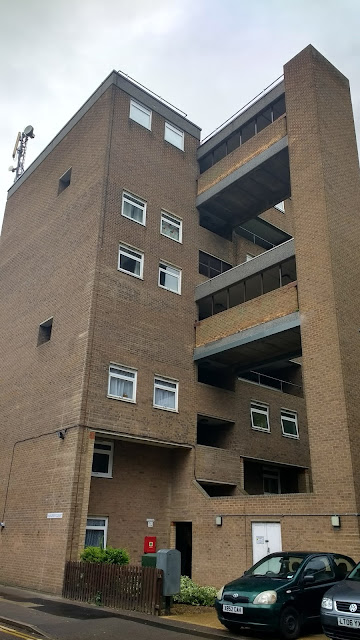
St Paul's School has its current location opposite. A notice about funding next to one advertising a car boot sale indicating the financial climate of contemporary state education. Private schools St Mary's and Perse Girls School, a stone's throw away, undoubtedly are immune from these worries.
I
Below is the back window of the Panton Arms, the more upmarket of the two pubs in the area. Before the slum clearance there was at least one other, The Ship. After this disappeared a replacement Ship was built on Kings Hedges estate in Northern outskirts of Cambridge, one of very few estate/flat roofed pubs in the City. And future destination for a walk I think.
At the bottom of Russell Court there is a sort of depression used as a yard/car park. In one of the walls a Cambridge Coat of Arms has been incorporated. The helmet was not added to the coat of arms until 1974 which might pre-date the wall but not by much. 1974 was also the year Cambridge was re-awarded City status.
The windows peering over the wall behind the coat of arms belong to The Alma, the other pub in the area. It used to be called the Alma Brewery until sometime into the 90s. Around that time it seemed a thing for pubs to drop the end bit off their names, becoming 'the something' instead of 'the something Arms' etc. It's still renowned for live music. There is a regular Sunday night open mike slot called 'Songsmith Sessions', run by Ezio, one of Cambridge's more famous local musos, who had the dubious honour of being featured in Tony Blair's desert island disc selection.
The Alma is one of those pubs I've not visited much, other than the occasional work do. I've never managed to see any music there either. My first attempted visit to the pub, and only attempt to go to a gig there, was to see a local rock band called 'Colonel Gomez' when I was about 15. The landlord at the time was a chap called Nick Wittington who later went on to stand for the Monster Raving Looney Party in Cambridge as well as running other pubs and having an impressive collection of hats. He wasn't loony enough to lose his licence for letting in underaged drinkers and told us in no uncertain terms we had to leave and wouldn't be seeing the band. Arriving on my mums shopper bike might not have helped my cause.
The compere of the Songsmith Sessions is Tom Dalpra, a musical character who has been around since my youth when he used to front the local band Nutmeg. They won the Cambridge Rock Competition the first year I went to it (1988?) and were quite a big thing locally after that for a few years. Colonel Gomez had played the rock competition probably a year or two before that (the link above is at the event I think). Both bands were staples of the local rock scene of my youth and passing the Alma dredged up memories of sweaty mosh pits, getting drunk and mostly poor attempts at relations with the opposite sex at places like the Sea Cadet Hall, the Burleigh Arms and The Boat Race. None at the Alma though, which is the only one still there.
Across the street the Christian Science Church were soon to host a summer soiree, shamefully showing how long it's taken me to get round to writing this blog. The building has been used as a polling station for many years. It was upgraded in 2011 and is hired out for various community activities, as an exam hall and for music. One of the few things left in Cambridge that's cheap (and in many cases free) are lunchtime concerts and talks at various churches and University buildings. These are not always very well advertised and have to be sought out a bit if you're not in the know or stumbled on by accident. I went to a talk a while back at a part of the University with Iain Sinclair and Nick Papadimitriou. It was part of an opening night of an art exhibition on edgelands and space. I can't recall how I found out about it but these things go on all the time. Nick Papadimitriou said it was the first time he had arrived in Cambridge by train since doing his A-Levels at CCAT in the 70s. I think his first impressions of 'See Bee 2' were on par with mine. Anyhow, the Christian Science Church is on the circuit of free and obscure events, although probably not many featuring psychogeographers.
By contrast, at the Cambridge Masonic Hall round the corner on Bateman Street 'very limited opportunity' for private functions and business seminars is available. This is the meeting place of the Lodge of The Three Grand Principles No.441, who acquired the building in 1968. Previously it was occupied by Cheshunt College, a Theological college which had merged the year before with Westminister College on Madingley Road. Before this, for just over 100 years, until 1962, Lodge No. 441 had met at the Red Lion Hotel, moving due to the development that would soon after see the coming of the Red Lion Statue to the same spot. If I were a conspiracy theorist I'm sure I could come up with some sinister connection between these events. But I'm not. However, there was a connection with this walk, since it was about the Red Lion and it's former site. That's good enough for me.
The building seems also to be used by the three private educational establishments listed on the sign above. The main St Mary's school is just across the street. The other two I had never heard of. Looking through the gates into the grounds made me wonder how I had not noticed this building before, while other places in the area were well known to me.
Onto Trumpington Road, one of the main routes in and out of Cambridge, I crossed Hobson's Conduit This waterway runs from the Nine Wells, beyond Addenbrokes Hospital at the edge of Cambridge, into town. Designed to bring clean water into town and named after Thomas Hobson, entrepreneur and philaphropist who provided much of the funding. He is probably best known for the expression 'Hobson's choice, coined by the poet John Milton and a reference to the way Hobson hired his horses to people. The customer could choose the next one in line by the staable door or none at all. The conduit, aka Hobsons's Brook, is a walk I'll save for another day.
I have clear memories of the wall below having 'Theatre of Hate' painted on it in large letters, probably in the early 80s. I would have gone past it on the way to the dentist in my dad's car, probably the only time I would have seen it in those days. I'm certain it was there for some time, but like an obscure childrens TV programme, it's something nobody else I talk to seems to remember. The same is true of the legend 'Jack the Biscuit is Skinhead OK' spray painted in a similar size on a wall across town on Perne Road around the same time. Seemingly connected to this one was a smaller bit of graffitti in Cherry Hinton that said 'Jack The Biscuit is Fred The Carpet'. I think I probably knew that Theatre Of Hate were a band, I think they had been on Top of The Pops. But Jack the Biscuit was an unknown quantity, and since it involved Skinheads, one that indicated violence in my young mind.
None of my friends knew who Jack the biscuit/Fred the Carpet were and I had never heard of the Kray Twins at the time or Jack 'The Hat' McVitie (Jack the Biscuit - get it?). Had a local skinhead assumed the moniker? Was the graffitti artist was refering to himself? Or did Jack live only in his imagination, as he did in mine? Maybe it was a cryptic message between groups of football hooligans. Theatre of Hate and Jack The Biscuit have been removed from both walls for years ago now and seemingly the collective memory to.
I've never been sure of the name of the area of green which occupies the space between the footpath along the wall and that following the course of another branch of Hobson's conduit (directy behind the camera in the picture). A bit further along this branch of the brook is Sheeps Green/Lammas Land and Coe Fen. I've never been sure which is which, my parents used to refer to it all as 'Newnham', which is the name of the suburb/village just West and North of the green spaces. Helpfully, this map seems to suggest this bit is called 'New Bit' which may or may not be the proper name. I reckon 'Theatre of Hate Wall Green' would be a better one.
Along the brook there are a couple of crossings to schools and private houses, as well as the one above with an intriguing passage to somewhere in the direction of Chaucer Road, a very 'Gown' area of Cambridge. I'd never been down it and made a mental note to revisit.
Above is a bit of Coe Fen (according to the map just referred to). Cambridge is quite good at green spaces and this area is one of the better ones, particularly in winter when there are less people about. It has a bizarre marshy quality and slight otherworldlyness.
I carried on until I reached the Lammas Land paddling pool. It being autumn, it was closed for use and had been drained. In the grey light of the day, the blue of the bottom of the pool looked intense. I don't know what they use for lining it.
The sign explaining the seasonal closure wanted to direct me to the website of an organisation called 'Better' so I could find out how they could help me keep active active over the winter. I wasn't aware of Better, probably because I don't use gyms and swimming pools. I've had a look since and it is the public facing 'brand' of Greenwich Leisure Limited, a social enterprise initially set up to remove the burden of providing leisure facilities, such as swimming pools and libraries, from the local authorities in Greenwich. I notice on their website displays the logo of the 'Big Society Awards 2011'. Around that time, 'The Big Society' was an idea promoted by the conservative MP Eric Pickles when he was Secretary of State for Local Government (or something like that). It was basically a way of moving the provsion of as many public social services as possible to anyone other than local or central and Government, as cheaply as possible. Often by volunteers for free, if not by other 'third sector' organisations such as social enterprises and other charities. This is still going on, of course, even though the slogan 'Big Society' is seldom used anymore. It's just seen as 'business as usual' these days.
I'm not sure who is responsible for the ice cream art above but I'd wager it's a product of the third sector, probably unpaid primary school children.
On Lammas Land next to the paddling pool is a childrens play area. I used to come here as a kid and play on the rides. I was pleasantly surprised that some of the old ones were still here. The roundabout and horse shown below are things I thought would long since have been replaced and would be considered old hat and probaly too dangerous these days, even without the concrete bases they used to have.
The way the horses head was painted now reminded me of a hobby horse, like those seen in the parade in The wicker Man or sometimes with Morris dancers . Before it would have been painted red all over, resembling a mutant chess piece. The playground horse is a bizarre creature in, being elongated enough to accommodate five saddles and having no legs.
It was early Saturday afternoon and the area was pretty much deserted and no children were playing there at all. Granted, it was raining a bit and late September. From a purely selfish point of view I was glad of this. It was the nearest I'd get in Cambridge to wandering around an abandoned fairground.
Nearby a couple of trees were partly pointed blue, giving off a glowing hue in the grey light of the day. Almost a reflection of the paddling pool. I don't know if this a mark of disease and impending removal by tree surgeons. It would be nice to think they were connected to the 'Blue Trees project' in America but I suspect not. There would have been a notice or something.
I followed the path to the bowling pavillion and crossed the road before heading down a road called 'Summerfield' that I'd never been down. It lead to a sports field and tennis court, which according to google maps is Gonville and Caius College Sports Ground. When I arrived nobody was around, although an 'annual gathering' was due to take place, probably for alumi of the college (or another college). The decription of these events, which sound very formal, can be found here. I'd never heard of anyone being 'Marticulated' before reading this. A student is marticulated when they are enrolled at a college formally and a ceremony involving things like formal photographs, dinners and services. A bit like a graduation but at the beginning of University instead of the end. Students become members of colleges for life and hence are invited back for the annual gatherings, mainly I think to extract donations from them. Such are the bizarre rituals and rites that go on in the University.
Next to the tennis court I spotted an open gate and footpath , running between the sports field and the back of some houses. There were no signs to say I shouldn't, so I followed it. Having lived in Cambridge as long as I have, I'm glad there are still plenty of nooks and crannies I've never explored and don't yet know exist. The path was pointing the right way to the Lion so I was hoping to find a way there which meant I could avoid the familiar route of Barton Road (a main road to the left of here).
The path turned left after it ran out of backs of houses and was diverted by another sports field which couldn't be accessed. I found myself in Clare Road, another place up to now unknown to me. It had large houses and the feel of a private road to begin with. I felt a bit self concious and wondered if I was 'allowed' here. It was eerily quiet and I saw no-one. There were no signs so I pressed on. I had a rucksack and could probably pass myself as a lost middle aged walker from out of town (it would only be partly untrue!).
I little way along on the right was St Mary's Court, yet another road I'd never been down. Hoping there was a route through to Grange Road, I turned right into it. The dwellings here were considerably less grand than those in the surronding areas, they looked like they may have been council housing originally, mostly of the unsual flat roofed type as seen in the picture below. It was like walking into a completely different part of town.
The road ended but turned into a footpath leading to another road which turned left and out onto Grange Road. Opposite was another intriguing road/path, this time leading to 'Leckhampton', a post graduate facility belonging to Corpus Christi College. There was no doubt this was private, so I carried on along Grange Road.
In later years I got to know a few people at Cambridge University, mostly ones who were involved in the 'Gong Appreciation Society' and who mingled with locals like me. They used to hold 'GAS Discos', usually at Clare College Cellars. I was able to visit bits of collages, mainly bars but also halls of residence and dining rooms with these people. Although my perception of students had changed - they were younger and didn't look like Bamber Gasgoine anymore - the atmosphere still felt the same as it had when I was a kid- still a bit other, a bit late 70s. My brain seems to bring this to the fore when areas like Grange Road, as if it's stuck with this imaginary perception from my earliest encounters of the University of Cambridge.
I pondered this until I got to the point of my walk. The Cambridge University Rugby Union Football Club has a Red Lion as it's symbol. The club will mark it's 150th anniversary in 2021. It's website bears the slogan 'Roaring Louder, Roaring Prounder'. But like everyone else, they seem to be undergoing some financial hardship having made losses for the last three years and are eating into their reserves. They are tapping up the alumni as part of their funding and development plan.
At the moment though, they haven't resorted to extracting money from visitors to see the Lion, or even worse raffling him in a charity draw. Nobody stopped me going in. The gate was open and a couple of people appeared to have arrived early for a rugby match but ignored me and I ignored them.
It was at the sametime magical and mundane to see the Lion again. It was in a car park next to some fire escape stairs, a less than magnificent setting. I'm not sure if this is a permenant arrangement but presumably funding a plinth is not a priority in the current financial climate. But at least it is being looked after and on display for those who can be bothered to make the trek to Grange Road. I think it is on a bus route for those less enthused by walking.
I was glad I'd finally seen the Lion in it's new setting. If it had always been here it would have fitted in, I wouldn't have batted an eyelid. Afterall, the University is inundated with heraldry and symbolism, which often incorporates lions and other animals. But it hasn't and it felt out of place, like when you see a person you know at random in a place you've never associated with them or never expected to see them in. I couldn't help but equate the 'banishment' and 'trapping' of the Lion to this space with the ongoing gentrification and change in Cambridge. It was as if by restraining the Lion these forces have been left unchecked without any significant challenge while they push out the old and replace it with the new. The Lion looks a bit sad and demoralised. It would be nice to think if it was freed and put back in town the tide would turn (at least a bit). Like in the Lion, the Witch and The Wardrobe when the Lion leads the revolt against the Ice Queen and her turkish delight. If this brought about the revival of 'Golden Egg' cafes instead of Costa Coffee, so much the better.
I reflected on this admittedly whimsical analogy while I walked away. I wondered if I was wallowing too much in nostalgia (there's a fine line between that and psychogeography I think). I also considered that when I started to do walks the aim was to seek out the interesting and bizarre, and escape the everyday through the mundane. But I'd just ended up ranting on about gentrification. In many cities this is something that is both physically and mentally difficult to escape from, and in Cambridge it is rife.
As I had reached my destination, the walk was 'officially' ended. Except I still had to walk home. I carried on down Grange Road and eventually found myself at The Punter in Northampton Street, where I escaped gentrification temporarily with a pint of Turpin's Black. Here's a few more pictures from that stretch finishing with a view of the wallpaper and grafiiti in the gents at the Punter.
Above a modern sculpture in front of an old building. No idea of it's significance.
Above the red brick brutalist Robinson College. A sometime venue for GAS discos I recall and a college attended by a couple of people I still know from that time. Around the same time Nick Clegg, the Liberal Democrat, also attended this college (not the GAS discos though, I don't think). From this angle the building looks not unlike Hanover Court.
Subscribe to:
Posts (Atom)
